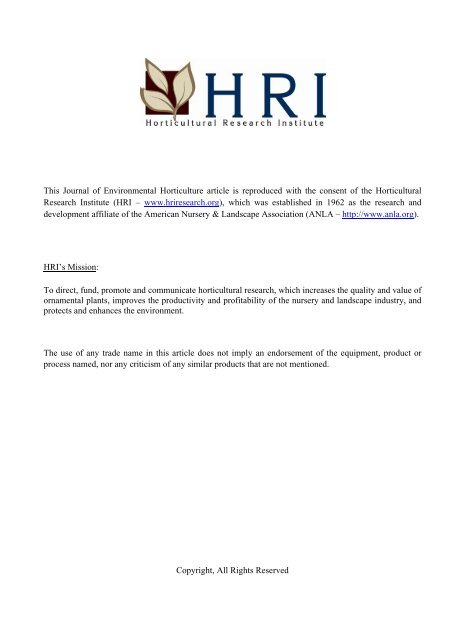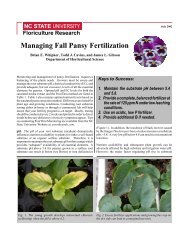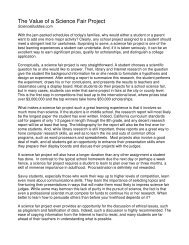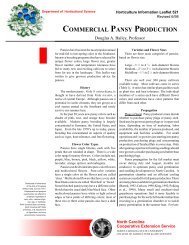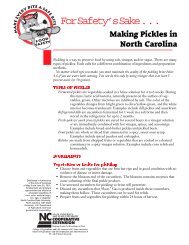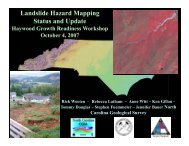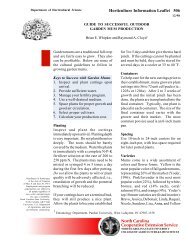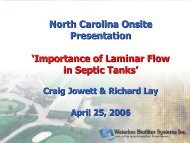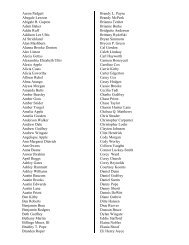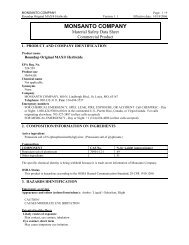Use of paclobutrazol to regulate shoot growth and flower
Use of paclobutrazol to regulate shoot growth and flower
Use of paclobutrazol to regulate shoot growth and flower
You also want an ePaper? Increase the reach of your titles
YUMPU automatically turns print PDFs into web optimized ePapers that Google loves.
This Journal <strong>of</strong> Environmental Horticulture article is reproduced with the consent <strong>of</strong> the Horticultural<br />
Research Institute (HRI – www.hriresearch.org), which was established in 1962 as the research <strong>and</strong><br />
development affiliate <strong>of</strong> the American Nursery & L<strong>and</strong>scape Association (ANLA – http://www.anla.org).<br />
HRI’s Mission:<br />
To direct, fund, promote <strong>and</strong> communicate horticultural research, which increases the quality <strong>and</strong> value <strong>of</strong><br />
ornamental plants, improves the productivity <strong>and</strong> pr<strong>of</strong>itability <strong>of</strong> the nursery <strong>and</strong> l<strong>and</strong>scape industry, <strong>and</strong><br />
protects <strong>and</strong> enhances the environment.<br />
The use <strong>of</strong> any trade name in this article does not imply an endorsement <strong>of</strong> the equipment, product or<br />
process named, nor any criticism <strong>of</strong> any similar products that are not mentioned.<br />
Copyright, All Rights Reserved
<strong>Use</strong> <strong>of</strong> Paclobutrazol <strong>to</strong> Regulate Shoot Growth <strong>and</strong><br />
Flower Development <strong>of</strong> 'Roseum Elegans' Rhododendron 1<br />
Thomas G. Ranney, Richard E. Bir, Joseph L. Conner <strong>and</strong> Everett P. Whitman II<br />
North Carolina State University, Mountain Horticultural Crops Research <strong>and</strong> Extension Center<br />
Department <strong>of</strong> Horticultural Science. 2016 Fanning Bridge Road. Fletcher; NC 28732-3562<br />
.------------------- Abstract ------------------,<br />
'Roseum Elegans' rhododendron (Rhododendron sp. L.) were grown in 2.5 I (#1) containers <strong>and</strong> treated with foliar sprays <strong>of</strong> 50, 100,<br />
<strong>and</strong> 200 ppm or root-zone drenches <strong>of</strong>2.5 (0.89), 5.0 (1.78), 10.0 (3.55), <strong>and</strong> 20.0 (7.10) ppm (mg ai/plant) <strong>of</strong><strong>paclobutrazol</strong> immediately<br />
following completion <strong>of</strong> the first flush <strong>of</strong> annual <strong>shoot</strong> <strong>growth</strong>. Shoot lengths <strong>of</strong> the subsequent <strong>growth</strong> flush following treatment were<br />
decreased with increasing rates <strong>of</strong> <strong>paclobutrazol</strong> when applied as either a drench or foliar spray. Drenches were more effective in<br />
suppressing <strong>shoot</strong> length with less active ingredient than were foliar sprays. The number <strong>of</strong> <strong>flower</strong> buds per plant increased with<br />
increasing rates <strong>of</strong> <strong>paclobutrazol</strong> when applied as a drench but not as a foliar spray. The highest drench rate resulted in 8.0 <strong>flower</strong><br />
buds/plant, a 240% increase over non-treated plants. No phy<strong>to</strong><strong>to</strong>xicity was observed from any <strong>of</strong> the treatments; however, inflorescence<br />
diameter, measured the year following treatment, was slightly « 1.1 em, < 7.5%) reduced with increasing rates <strong>of</strong> <strong>paclobutrazol</strong><br />
when applied as a drench. Aowering duration, the period from bud break <strong>to</strong> abscision <strong>of</strong> the last <strong>flower</strong>, increased with increasing<br />
rates <strong>of</strong> <strong>paclobutrazol</strong> for both application methods with a maximum increase <strong>of</strong> 5.6 days for the highest drench treatment. Length <strong>of</strong><br />
<strong>shoot</strong> <strong>growth</strong> the year following treatment was reduced by as much as 33% with increasing <strong>paclobutrazol</strong> rates when applied as a<br />
drench but not as a foliar spray.<br />
Index words: <strong>flower</strong>ing, plant <strong>growth</strong> regula<strong>to</strong>r, phenology, production.<br />
Chemicals used in this study: Bonzi'" (<strong>paclobutrazol</strong>), (±)-(R',R')-B-[(4-chlorophenyl)methyl)-lX-(1,1,-dimethylethyl)-IH-l,2.4,triazole-l-ethanol.<br />
Species used: 'Roseum Elegans' Rhododendron (Rhododendron sp. L.).<br />
Significance <strong>to</strong> the Nursery Industry<br />
Some vigorous growing rhododendron cultivars, e.g.<br />
'Roseum Elegans', tend <strong>to</strong> have excessive <strong>shoot</strong> <strong>growth</strong> <strong>and</strong><br />
delayed or limited <strong>flower</strong> initiation under favorable <strong>growth</strong><br />
conditions. Results indicated that <strong>paclobutrazol</strong> applied as<br />
either a root-zone drench or foliar spray was effective in<br />
reducing <strong>shoot</strong> <strong>growth</strong> <strong>and</strong> in some cases increasing <strong>flower</strong><br />
bud number in container grown 'Roseum Elegans' rhododendron<br />
with minimal undesirable side effects. Foliar sprays<br />
were much less effective than drench treatments in reducing<br />
<strong>shoot</strong> <strong>growth</strong> <strong>and</strong> had no effect on <strong>flower</strong> bud number,<br />
suggesting that foliar rates may need <strong>to</strong> be greater than 200<br />
ppm <strong>to</strong> b.e effective under our growing conditions. Root-zone<br />
drenches in the range <strong>of</strong> 10-20 ppm (3.55-7.10 mg ai/plant)<br />
proved <strong>to</strong> be most effective, resulting in more compact plants<br />
with greater numbers <strong>of</strong> <strong>flower</strong> buds. Due <strong>to</strong> the potential<br />
for changing efficacy based on environment, growing conditions,<br />
<strong>and</strong> cultivar sensitivity, rates may need <strong>to</strong> be adjusted<br />
for variations in these fac<strong>to</strong>rs.<br />
Introduction<br />
When growing rhododendrons in commercial production,<br />
it is typically desirable <strong>to</strong> produce a compact, evenly branched<br />
plant with an abundance <strong>of</strong> <strong>flower</strong> buds. Achieving these<br />
goals can require skillful manipulation <strong>of</strong> fertilizer, irrigation,<br />
light level, <strong>and</strong> pruning with all being adjusted for the<br />
specific <strong>growth</strong> characteristics <strong>of</strong> a given species or cultivar.<br />
'Received for publication March 18. 1994; in revised fonn June 3. 1994. The<br />
work reported in this publication was supported in part by the North Carolina<br />
Agricultural Research Service. Raleigh. NC <strong>and</strong> Uniroyal Chemical Company,<br />
Middlebury. cr. Technical assistance <strong>of</strong> personnel at the Mountain Horticultural<br />
Crops Research Station is gratefully acknowledged.<br />
174<br />
Some rhododendron hybrids, including 'Roseum Elegans'<br />
rhododendron (Rhododendron sp.), can be difficult <strong>to</strong> manage<br />
as they can have undesirable, vigorous <strong>growth</strong> characteristics<br />
resulting in long internodes, floppy <strong>growth</strong> habits,<br />
<strong>and</strong> few <strong>flower</strong> buds.<br />
Considerable research has been conducted on the use <strong>of</strong><br />
<strong>growth</strong> regula<strong>to</strong>rs for controlling <strong>shoot</strong> elongation <strong>and</strong> <strong>flower</strong><br />
initiation in rhododendrons. Stuart (16) first reported that<br />
the <strong>growth</strong> regula<strong>to</strong>rs chlorphonium (phosphon) <strong>and</strong><br />
chlormequat chloride could effectively retard <strong>shoot</strong> <strong>growth</strong><br />
while stimulating initiation <strong>of</strong> <strong>flower</strong> buds in azaleas (Rhododendron<br />
spp. L.).<br />
Later work has further evaluated the effectiveness <strong>and</strong> limitations<br />
<strong>of</strong> a variety <strong>of</strong> plant <strong>growth</strong> regula<strong>to</strong>rs on Rhododendron<br />
spp. The <strong>growth</strong> regula<strong>to</strong>r daminozide has been shown<br />
<strong>to</strong> increase <strong>flower</strong> initiation <strong>of</strong> Rhododendron spp., but has<br />
given inconsistent control <strong>of</strong><strong>shoot</strong> <strong>growth</strong>, generally required<br />
multiple applications <strong>of</strong> foliar sprays, <strong>and</strong> in some cases,<br />
high rates reduced <strong>flower</strong> size, diminished <strong>flower</strong> color, <strong>and</strong><br />
delayed <strong>flower</strong> development (5, 8, 11, 12, 18). Similarly,<br />
chlormequat chloride has been shown <strong>to</strong> increase <strong>flower</strong> bud<br />
number in Rhododendron spp., but the affects on <strong>shoot</strong> elongation<br />
are sometimes inconsistent <strong>and</strong> transi<strong>to</strong>ry, multiple<br />
foliar sprays are generally required, <strong>and</strong> high rates may result<br />
in abnormal <strong>flower</strong>s, advanced or delayed bloom time,<br />
leaf curl, <strong>and</strong> leaf margin necrosis (5, 8, 11, 12, 17, 18).<br />
Limited testing <strong>of</strong> ancymidol has indicated that this chemical<br />
can inhibit <strong>shoot</strong> <strong>growth</strong> <strong>and</strong> promote <strong>flower</strong> initiation<br />
in rhododendron, but was less effective than daminozide or<br />
chlormequat chloride (20) <strong>and</strong> plants were affected over a<br />
narrow concentration range (4). Chlorphonium has given<br />
some <strong>of</strong> the most promising results <strong>and</strong> has been shown <strong>to</strong><br />
provide effective control <strong>of</strong> <strong>shoot</strong> <strong>growth</strong> <strong>and</strong> increase <strong>flower</strong><br />
initiation, but on some cultivars (e.g. R. 'Roseum Elegans')<br />
resulted in smaller, paler <strong>flower</strong>s, <strong>and</strong> limber stems with<br />
1. Environ. Hort. 12(3):174-178. September 1994
side effects lasting several years (5, 11, 12, 16). Furthermore,<br />
chlorphonium is no longer available as a commercial<br />
plant <strong>growth</strong> regula<strong>to</strong>r.<br />
Most recently, triazole <strong>growth</strong> regula<strong>to</strong>rs, including<br />
<strong>paclobutrazol</strong>, have been found <strong>to</strong> effectively <strong>regulate</strong> <strong>shoot</strong><br />
length <strong>and</strong> <strong>of</strong>ten increase <strong>flower</strong> initiation in a wide range<br />
<strong>of</strong> woody plants (1, 6, 7,9,10,15,21). <strong>Use</strong><strong>of</strong><strong>paclobutrazol</strong><br />
on Rhododendron spp. has also been promising. Joustra (8)<br />
reported that <strong>paclobutrazol</strong> was a more effective <strong>growth</strong> regula<strong>to</strong>r<br />
than daminozide or chlormequat for selected rhododendron<br />
<strong>and</strong> azalea cultivars. In a comparison among 8 plant<br />
<strong>growth</strong> regula<strong>to</strong>rs, Whealy et aI. (20) found that <strong>paclobutrazol</strong><br />
was one <strong>of</strong> the most efficient <strong>and</strong> effective chemicals for<br />
reducing <strong>shoot</strong> length, without affecting <strong>flower</strong> size or time<br />
<strong>to</strong> <strong>flower</strong> in 'Gloria' azalea (R. obtusum). In addition <strong>to</strong> regulating<br />
<strong>shoot</strong> <strong>growth</strong>, research has indicated that <strong>paclobutrazol</strong><br />
can increase <strong>flower</strong> initiation, is effective as a foliar or drench<br />
application, <strong>and</strong> that foliar sprays are <strong>of</strong>ten effective with<br />
only one application on a number <strong>of</strong> Rhododendron spp. (8,<br />
<strong>to</strong>, 20, 22). Although many <strong>of</strong> the results with <strong>paclobutrazol</strong><br />
are promising, some undesirable side effects, including malfonned<br />
leaves, prolonged <strong>growth</strong> suppression, reduction in<br />
<strong>flower</strong> diameter, <strong>and</strong> delayed <strong>flower</strong>ing, have been reported<br />
for Rhododendron spp. treated with high rates <strong>of</strong><br />
<strong>paclobutrazol</strong> (8, 10,21). It has also been reported that different<br />
cultivars <strong>of</strong> rhododendron can vary considerably in<br />
sensitivity <strong>to</strong> <strong>paclobutrazol</strong> (8).<br />
The objectives <strong>of</strong> this project were <strong>to</strong> evaluate the effect <strong>of</strong><br />
<strong>paclobutrazol</strong> rate <strong>and</strong> application method (foliar spray <strong>and</strong><br />
root-zone drench) on <strong>shoot</strong> <strong>growth</strong>, <strong>flower</strong> initiation, <strong>flower</strong>ing<br />
phenology <strong>and</strong> duration, <strong>and</strong> phy<strong>to</strong><strong>to</strong>xicity on 'Roseum<br />
Elegans' rhododendron.<br />
Materials <strong>and</strong> Methods<br />
Container-grown 'Roseum Elegans' rhododendron liners<br />
were transplanted in<strong>to</strong> 2.5 1(#1) black plastic containers in<br />
April 1992. The container media consisted <strong>of</strong> milled pine<br />
bark:sphagnum peat (5: 1 by vol) amended with dolomitic<br />
limes<strong>to</strong>ne at 4.2 kglm 3 (7.0 Ibslyd 3 ). Plants were then grown<br />
outdoors on a gravel bed located at the Mountain Horticultural<br />
Crops Research Station in Fletcher, NC. Irrigation was<br />
applied as needed via spray emitters placed in each container<br />
<strong>and</strong> located below the leaf canopy <strong>of</strong> the plants. Thirteen<br />
grams (0.46 oz) <strong>of</strong> 22N-1P-8K (22-3-10 ProKote Plus,<br />
a.M. Scott, Marysville, OH) was surface-applied <strong>to</strong> each<br />
container on June 15, 1992.<br />
Treatments were applied on June 5, 1992 following cessation<br />
<strong>of</strong> the first <strong>growth</strong> flush. Paclobutrazol (Bonzi, 0.128%<br />
L, Uniroyal Chemical Company, Middlebury, CT) was applied<br />
either as a foliar spray or as a root-zone drench (Table<br />
1). Foliar spray treatments <strong>of</strong> 50, 100, <strong>and</strong> 200 ppm<br />
<strong>paclobutrazol</strong> were applied with approximately 2.2 oz (65<br />
ml)/plant <strong>to</strong> the point immediately prior <strong>to</strong> run-<strong>of</strong>f with a<br />
h<strong>and</strong>-held sprayer. Root-zone drenches consisted <strong>of</strong> 355 ml<br />
(12 oz) <strong>of</strong> solution applied per plant at 2.5, 5.0, 10, <strong>and</strong> 20<br />
ppm <strong>paclobutrazol</strong>. Weather was partly cloudy/overcast with<br />
no rain that day. Air temperature at time <strong>of</strong> treatment was<br />
22°C (72°F). The experimental design was a r<strong>and</strong>omized<br />
complete block with twelve single-plant replications.<br />
Flower bud number <strong>and</strong> <strong>shoot</strong> <strong>growth</strong> were measured in<br />
Oc<strong>to</strong>ber 1992. Shoot <strong>growth</strong> was measured as the length<br />
from the last terminal bud scar <strong>to</strong> the terminal point for<br />
each <strong>of</strong> the three longest <strong>shoot</strong>s <strong>of</strong> each plant. This mea-<br />
J. Environ. Hort. 12(3):174-178. September 1994<br />
Table 1. Rates <strong>and</strong>application metbodsfor <strong>paclobutrazol</strong> (Bonzi.128%<br />
L) applied <strong>to</strong> 'Roseum Elegans' rhododendron.<br />
Application rates<br />
Treatment ppm mgajJplant grains ai/plant<br />
Control 0.0 0.00 0.000<br />
Foliar spray' 50.0 3.25 0.050<br />
100.0 6.50 0.101<br />
200.0 13.00 0.201<br />
Root-zone drench Y 2.5 0.89 0.014<br />
5.0 1.78 0.027<br />
10.0 3.55 0.055<br />
20.0 7.10 0.110<br />
'Applied <strong>to</strong> the point <strong>of</strong> run-<strong>of</strong>f with an average volume <strong>of</strong>65 ml (2.2 oz) per<br />
plant.<br />
YApplied with a volume <strong>of</strong> 355 ml (12 oz) per plant.<br />
surement reflected <strong>shoot</strong> <strong>growth</strong> <strong>of</strong> the one <strong>growth</strong> flush following<br />
treatment application.<br />
Plants were s<strong>to</strong>red in an unheated polyethylene greenhouse<br />
during winter <strong>and</strong> then moved in<strong>to</strong> a heated greenhouse<br />
on February I, 1993. Flowering characteristics, including<br />
inflorescence diameter, date <strong>of</strong> <strong>flower</strong> bud break,<br />
date <strong>of</strong> full bloom, <strong>and</strong> date <strong>of</strong> last <strong>flower</strong> drop were recorded<br />
for each individual inflorescence on each plant. Shoot<br />
<strong>growth</strong> was measured, as previously described, following<br />
the first <strong>growth</strong> flush in 1993.<br />
Results <strong>and</strong> Discussion<br />
1992 measurements. Shoot length <strong>of</strong> the first <strong>growth</strong> flush<br />
following treatment decreased with increasing rates <strong>of</strong><br />
<strong>paclobutrazol</strong> when treatments were applied either as a container<br />
drench (quadratic response, Fig. 1A) or foliar spray<br />
(linear response, Fig. 1B). However, container drenches were<br />
considerably more effective in reducing <strong>shoot</strong> length, with<br />
less active ingredient, than were foliar applications. A container<br />
drench <strong>of</strong> 20 ppm (7.1 mg ai/p1ant) resulted in a 66%<br />
reduction in <strong>shoot</strong> length vs. control plants, while a 200<br />
ppm foliar spray (13.0 mg ai/plant) resulted in only a 24%<br />
reduction in <strong>shoot</strong> length.<br />
The number <strong>of</strong><strong>flower</strong> buds increased with increasing rates<br />
<strong>of</strong> <strong>paclobutrazol</strong> when applied as a container drench (linear<br />
response, Fig. 1C), but not when applied as a foliar spray<br />
(Fig. 1D). Plants treated with a 20 ppm drench had a mean<br />
<strong>of</strong> 8 <strong>flower</strong> buds per plant, representing a 242% increase<br />
over the controls.<br />
1993 measurements. Inflorescence diameter was reduced<br />
slightly with increasing concentrations <strong>of</strong> <strong>paclobutrazol</strong> when<br />
applied as a container drench (linear response, Fig. 2A), but<br />
not when applied as a foliar spray (Fig. 2B). However, the<br />
reduction in inflorescence diameter, even for plants treated<br />
at 20 ppm as a container drench was small, < 1.1 cm or a<br />
7.5% reduction, compared <strong>to</strong> the control plants, <strong>and</strong> would<br />
probably not be an important fac<strong>to</strong>r for the average consumer.<br />
Flowering duration, defined as the period from <strong>flower</strong> bud<br />
break <strong>to</strong> abscission <strong>of</strong> the last <strong>flower</strong>, increased in a linear<br />
response with increasing rates <strong>of</strong> <strong>paclobutrazol</strong> when applied<br />
both as a root-zone drench (Fig. 2C) <strong>and</strong> foliar spray<br />
(Fig. 2D). Flowering duration increased by as much as 5.5<br />
days for plants treated with 20 ppm root-zone drench <strong>and</strong><br />
4.6 days for plants treated with 200 ppm foliar spray. There<br />
175
was no effect <strong>of</strong> <strong>paclobutrazol</strong>, regardless <strong>of</strong> application<br />
method, on mean date <strong>of</strong> <strong>flower</strong> bud break or mean date <strong>of</strong><br />
full bloom (data not shown). Thus, the increase in <strong>flower</strong>ing<br />
duration in response <strong>to</strong> <strong>paclobutrazol</strong> appeared <strong>to</strong> result<br />
from a delay in <strong>flower</strong> senescence <strong>and</strong>/or <strong>flower</strong> abscision.<br />
Although an increase in <strong>flower</strong> duration may be considered<br />
desirable, the quality <strong>of</strong> these inflorescences with many abscised<br />
<strong>flower</strong>s <strong>and</strong> the remainder <strong>of</strong>ten with flaccid petals<br />
suggests that this additional period <strong>of</strong> bloom should not be<br />
considered a time <strong>of</strong> peak plant attractiveness or salability.<br />
A reduction in <strong>shoot</strong> length <strong>of</strong> the first <strong>growth</strong> flush in<br />
1993, for plants treated in 1992, was evident with increasing<br />
concentrations <strong>of</strong> <strong>paclobutrazol</strong> when applied as a container<br />
drench (Fig. 3A) but not for plants treated with a foliar<br />
spray (Fig. 3B). Shoot length <strong>of</strong> plants that were treated<br />
with a 20 ppm container drench was reduced by 6.4 cm or<br />
33% as compared <strong>to</strong> controls. The amount <strong>of</strong> <strong>growth</strong> reduction,<br />
even for the 20 ppm root-zone drench, was not excessive<br />
the following year <strong>and</strong> in many cases would be considered<br />
desirable.<br />
No signs <strong>of</strong> foliar phy<strong>to</strong><strong>to</strong>xicity or deformation were evident<br />
for any <strong>of</strong> the treatments. Nor were there any signs <strong>of</strong><br />
root deformation as has been reported for other plants treated<br />
with root-zone applications <strong>of</strong> <strong>paclobutrazol</strong> (2, 14).<br />
ROOT-ZONE DRENCH<br />
10<br />
9 A<br />
Regression Analysis<br />
e o 8<br />
R2 =0.99; LiDear. P < 0.01; Quadratic. P < 0.01<br />
-- Shoot length .. 7.82 - 0.S3 ppm + 0.01 ppm'<br />
7<br />
6<br />
5<br />
4<br />
3<br />
2<br />
I<br />
10<br />
9 c<br />
8<br />
7<br />
6<br />
5<br />
4<br />
3<br />
2<br />
1 0<br />
.'.<br />
.. '<br />
Regression Analysis<br />
....<br />
R2 .. 0.98; Linear, P < 0.01; Quadratic, NS<br />
Shoot length .. 3.S0 + 0.22 ppm<br />
.' .<br />
2 4 6 8 I 0 12 14 16 I 8 20<br />
CONCENTRATION (ppm)<br />
Under the growing conditions imposed in this experiment,<br />
application rates <strong>of</strong> 10-20 ppm (3.5-7.1 mg, 0.05-0.11<br />
grains ai/plant) applied as a root-zone drench gave effective<br />
control <strong>of</strong> <strong>shoot</strong> length for two <strong>growth</strong> flushes following treatment<br />
<strong>and</strong> significantly increased <strong>flower</strong> bud number with<br />
no signs <strong>of</strong> phy<strong>to</strong><strong>to</strong>xicity. Keever et a1. (10) found that increasing<br />
rates <strong>of</strong> root-zone applied <strong>paclobutrazol</strong> up <strong>to</strong> 100<br />
mg (1.5 grains) ai/plant decreased <strong>shoot</strong> <strong>growth</strong> for 2 azalea<br />
cultivars grown in #1 containers with a pine bark medium,<br />
but that the greatest reduction in <strong>shoot</strong> <strong>growth</strong> typically occurred<br />
between 0-6 mg (Q-().1 grains) ai/plant. Wilkinson<br />
<strong>and</strong> Richards (22) reported that root-zone drenches <strong>of</strong><br />
<strong>paclobutrazol</strong> at rates from 100-400 mg (1.5-6.2 grains) ail<br />
plant <strong>to</strong> Rhododendron 'Sir Robert Peel' in 4.3 1 (1.1 gal)<br />
containers with a pine bark:s<strong>and</strong>y loam:s<strong>and</strong> (3: 1: 1 by vol)<br />
medium proved excessive <strong>and</strong> resulted in prolonged <strong>shoot</strong><br />
<strong>growth</strong> reduction <strong>and</strong> malformed <strong>flower</strong>s.<br />
Foliar sprays up <strong>to</strong> a concentration <strong>of</strong> 200 ppm provided<br />
minimal control <strong>of</strong> <strong>shoot</strong> <strong>growth</strong> <strong>and</strong> had no effect on <strong>flower</strong><br />
bud number in our research. Br<strong>and</strong> (3) recently reported that<br />
foliar sprays <strong>of</strong> <strong>paclobutrazol</strong> at rates as low as 10 ppm provided<br />
effective <strong>shoot</strong> control on 'Roseum Elegans' rhododendron,<br />
particularly if applied in April before the first flush<br />
<strong>of</strong> annual <strong>growth</strong>. Wilkinson <strong>and</strong> Richards (22) found that<br />
B ".<br />
D<br />
FOLIAR SPRAY<br />
Regression Analysis<br />
".<br />
R2 .. 0.96; Linear, P < O.OS; Quadratic. NS<br />
Shoot length .. 7.KS - 0.009 ppm<br />
Regression Analysis<br />
Linear, NS; Quadratic, NS<br />
".<br />
LSDo.05 =<br />
I<br />
o 20 40 60 80 100 120 140 160 180 200<br />
CONCENTRATION (ppm)<br />
Fig. 1. Response <strong>of</strong> <strong>shoot</strong> length <strong>and</strong> <strong>flower</strong> bud number <strong>to</strong> <strong>paclobutrazol</strong> rate for root-zone <strong>and</strong> foliar treated plants at the completion <strong>of</strong> the 1992<br />
growing season. Solid lines represent the predicted regression response in cases where regression terms were significant. Dotted lines represent<br />
a 95 % confidence interval for the mean response. Data points represent means, n .. 12.<br />
176<br />
J. Environ. Hort. 12(3):174-178. September 1994


